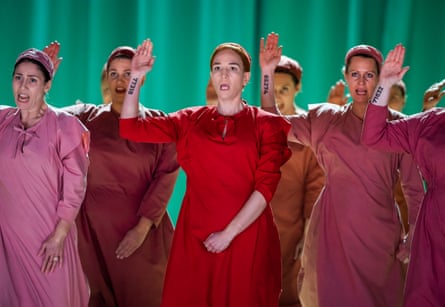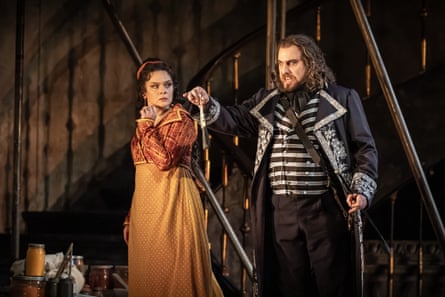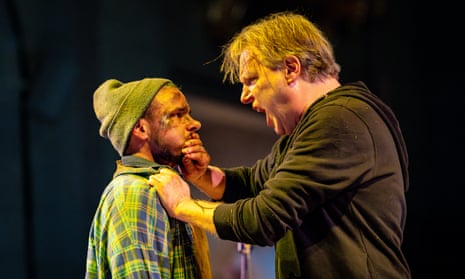As if released from starting blocks, Siegfried, hero of Wagner’s Ring, in black hoodie with teddy bear under his arm, hurtles through the audience at top speed and leaps on stage for his first vocal entry, impressively still in control of his breath. Mime, his slippery Nibelung keeper – green hair, woollen pixie hat – is ready to greet him. Then the god Wotan-Wanderer strolls in, disguised as a boiler-suited electrician with toolbox, there to change a lightbulb. All stagings of the Ring have directorial ideas. You can take or leave them. Regents Opera, which has reached the cycle’s third instalment, brings the epic to life with imagination, humour – including a homage to Marcel Duchamp’s urinal – and the occasional but fixable mishap.
Skilfully reduced to 23 orchestral players, in a painstaking and faithful arrangement by the conductor Ben Woodward, this is small-scale Wagner with big ambitions and high musical standards. The ear quickly adapts to the lean sound of a dozen strings and (four horns aside) single brass and woodwind. Directed by Caroline Staunton and designed by Isabella van Braeckel, the action takes place on a small, raised platform in the Grand Temple of Freemasons’ Hall. Props are minimal, sets all but nonexistent. Were not all the lines in this glorious art deco building straight, you would say the staging was in the round. It’s certainly up close, the drama immediate.
The opera’s first act consists largely of a long spat between Siegfried and Mime, and can drag: these two characters are irritating even by Wagnerian standards. Both singers here, heldentenor Peter Furlong and tenor Holden Madagame, worked hard to maintain energy, physically and vocally. Furlong was watchable, convincing and well able to jump through the role’s vocal hoops. Madagame, a trans activist who started his training as a mezzo-soprano, has spoken about the difficulties of securing a new voice type post testosterone treatment. His taut musicality and acting skills could not always compensate for a lack of tonal strength, but he brought engaging vitality to this unlikable character.
The rest of the cast – led by Catharine Woodward’s fearless and vehement Brünnhilde – excelled, as did the orchestra, fingers and lips surely raw at the end of this marathon work, with only brief lapses. Ralf Lukas, a resonant and dignified Wanderer, was cleverly matched by Oliver Gibbs as his lookalike counterpart, Alberich. Craig Lemont Walters, snaky and subtle as a gold-clad Fafner, Corinne Hart’s sweet-toned, bustling Woodbird and Mae Heydorn, gracious in every respect as Erda, all contributed with skill. The cycle began last year with Rheingold and Die Walküre (with the late Keel Watson as Wotan). It will be completed later this year.

Last month’s planned strike at English National Opera was averted in time for the revival of The Handmaid’s Tale, by Poul Ruders, libretto by Paul Bentley, based on Margaret Atwood’s novel and directed by Annilese Miskimmon. Having now seen the work three times, I still struggle with its unyielding nature, brilliant orchestral colours and stirring choral eruptions notwithstanding. This performance, however, was by far the most persuasive yet. Joana Carneiro, conducting, revealed unnoticed subtleties in the score, with Kate Lindsey once again bringing insight and feeling to the central role of Offred. Avery Amereau (Serena Joy), Nadine Benjamin (Moira), Rachel Nicholls (Aunt Lydia) and Zwakele Tshabalala (Nick) led a well-balanced ensemble. The sense of orchestra, chorus and production team working as one was palpable and rewarding – the more so given their collective uncertainty about ENO’s future.

Less triumphant was the Royal Opera House’s revival of Tosca, where it was hard to see how the casting had come about. Neither Ausrine Stundyte in the title role nor Marcelo Puente as Cavaradossi sounded on top form, though Stundyte – who stepped in recently for Nina Stemme in Elektra at ROH – acted well, reminding us of Tosca’s real horror at finding herself a murderer. Karen Kamensek, conducting, showed a confident grasp of Puccini’s ebbing-flowing score, which the orchestra played with due professionalism. Jonathan Kent’s majestic 2006 staging still works. The sudden appearance of Scarpia at the top of the steps in the basilica of Sant’Andrea della Valle, before the great Te Deum, chills and startles every time. Returning to the role, baritone Gabriele Viviani was the night’s standout performer, finding Italianate lyricism in this most creepy and thuggish of roles. Even in a decidedly non-vintage performance, the music seems ever more remarkable. Puccini wins every time. What a composer.
Star ratings (out of five)
Siegfried ★★★★
The Handmaid’s Tale ★★★★
Tosca ★★★
Siegfried is at Freemasons’ Hall, London, until 10 February
The Handmaid’s Tale is at the Coliseum, London, until 15 February

Comments (…)
Sign in or create your Guardian account to join the discussion